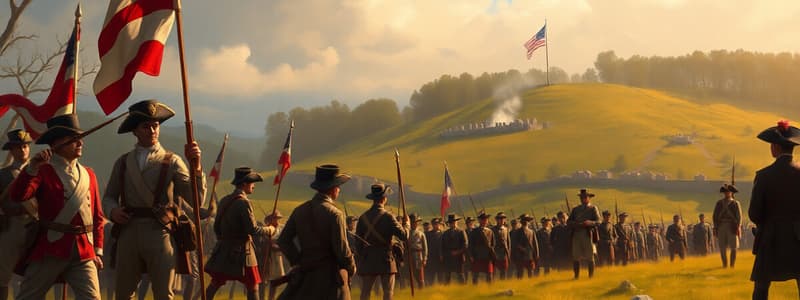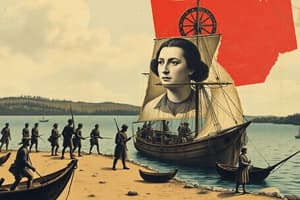Podcast
Questions and Answers
What was the strategy employed by the Green Mountain Boys during their attack on May 10, 1775?
What was the strategy employed by the Green Mountain Boys during their attack on May 10, 1775?
- Engaging in a drawn-out siege
- Attacking during daylight hours
- Negotiating a peaceful surrender
- Surprise attack while British were sleeping (correct)
Who were the leaders of the Green Mountain Boys?
Who were the leaders of the Green Mountain Boys?
- George Washington and Thomas Jefferson
- Samuel Adams and John Hancock
- Ethan Allen and Benedict Arnold (correct)
- Richard Henry Lee and Benjamin Franklin
What was the significance of the Battle of Bunker Hill?
What was the significance of the Battle of Bunker Hill?
- It was the first battle of the Revolutionary War
- It secured French support for the American cause
- It demonstrated that the colonists could withstand British forces (correct)
- It resulted in a decisive British victory
What was King George's response to the colonies' peace attempt?
What was King George's response to the colonies' peace attempt?
Which document did Thomas Jefferson draft that proclaimed the principles of American independence?
Which document did Thomas Jefferson draft that proclaimed the principles of American independence?
What unalienable rights are listed in the Declaration of Independence?
What unalienable rights are listed in the Declaration of Independence?
Who inspired many ideas in the Declaration of Independence?
Who inspired many ideas in the Declaration of Independence?
What decision did the Second Continental Congress make regarding military leadership?
What decision did the Second Continental Congress make regarding military leadership?
Flashcards are hidden until you start studying
Study Notes
The Colonial Army Forms
- The Green Mountain Boys, led by Ethan Allen and Benedict Arnold, surprised and captured Fort Ticonderoga on May 10, 1775.
- The capture of Fort Ticonderoga provided the Colonial forces with much-needed weapons and supplies.
- The Second Continental Congress met in Philadelphia, with delegates including Thomas Jefferson and Benjamin Franklin.
- The Congress appointed George Washington as Commander-in-Chief and renamed the colonial forces as the Continental Army.
- The Battle of Bunker Hill, fought on June 17, 1775 at Breed's Hill, resulted in a heavy defeat for the British despite the colonial retreat.
- The Battle of Bunker Hill demonstrated the colonists' ability to resist the British forces, despite their lack of resources.
Breaking with Britain
- The Second Continental Congress made a final attempt at peace by sending a letter to King George III, seeking a resolution between the colonies and Parliament.
- King George III responded by declaring the colonies in open rebellion.
- In January 1776, King George III hired 20,000 German soldiers, known as Hessians, to fight in America.
- By spring 1776, George Washington had successfully forced the British to evacuate Boston by moving heavy cannons to strategic positions.
- Thomas Paine's influential pamphlet, Common Sense, further galvanized the colonists' support for independence.
Drafting the Declaration
- In the spring of 1776, the Continental Congress acted as the colonial government.
- In June 1776, Richard Henry Lee proposed that the colonies should be free and independent states.
- A committee, including Thomas Jefferson, Benjamin Franklin, and John Adams, was formed to draft the Declaration of Independence.
- Thomas Jefferson was the main author of the Declaration of Independence.
- Congress formally voted to approve independence on July 2nd, 1776.
- The Declaration of Independence was adopted by Congress on July 4th, 1776.
- The Declaration states that all men are created equal and endowed with unalienable rights to life, liberty, and the pursuit of happiness.
- The Declaration was inspired by John Locke's philosophy of natural rights.
- Jefferson's initial draft included a condemnation of slavery, but it was removed due to debate.
- Women's rights were not addressed in the Declaration, despite Abigail Adams' plea.
- The Declaration listed grievances against King George III, including the imposition of taxes without colonial consent and the deployment of standing armies without their approval.
- July 4th, 1776 marks the official birth of the United States of America.
- As a result of the Declaration, the 13 colonies became free and independent states.
Studying That Suits You
Use AI to generate personalized quizzes and flashcards to suit your learning preferences.




